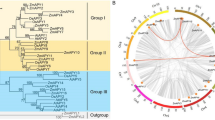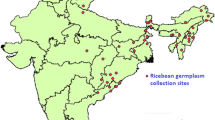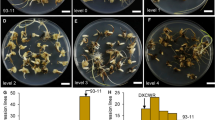Abstract
Cytoplasmic male sterility (CMS) offers a unique system to understand cytoplasmic nuclear crosstalk, and is also employed for exploitation of hybrid vigor in various crops. Pigeonpea A4-CMS, a predominant source of male sterility, is being used for efficient hybrid seed production. The molecular mechanisms of CMS trait remain poorly studied in pigeonpea. We performed genome-wide transcriptome profiling of A4-CMS line ICPA 2043 and its isogenic maintainer ICPB 2043 at two different stages of floral bud development (stage S1 and stage S2). Consistent with the evidences from some other crops, we also observed significant difference in the expression levels of genes in the later stage, i.e., stage S2. Differential expression was observed for 143 and 55 genes within the two stages of ICPA 2043 and ICPB 2043, respectively. We obtained only 10 differentially expressed genes (DEGs) between the stage S1 of the two genotypes, whereas expression change was significant for 582 genes in the case of stage S2. The qRT-PCR assay of randomly selected six genes supported the differential expression of genes between ICPA 2043 and ICPB 2043. Further, GO and KEGG pathway mapping suggested a possible compromise in key bioprocesses during flower and pollen development. Besides providing novel insights into the functional genomics of CMS trait, our results were in strong agreement with the gene expression atlas of pigeonpea that implicated various candidate genes like sucrose-proton symporter 2 and an uncharacterized protein along with pectate lyase, pectinesterase inhibitors, l-ascorbate oxidase homolog, ATPase, β-galactosidase, polygalacturonase, and aldose 1-epimerase for pollen development of pigeonpea. The dataset presented here provides a rich genomic resource to improve understanding of CMS trait and its deployment in heterosis breeding in pigeonpea.






Similar content being viewed by others
References
Alexa A, Rahnenfuhrer J (2019) topGO: enrichment analysis for gene ontology. R package version 2.36.0.
An H, Yang ZH, Yi B, Wen J, Shen JX, Tu JX, Ma C, Fu T (2014) Comparative transcript profiling of the fertile and sterile flower buds of pol CMS in B. napus. BMC Genomics 15:258
Andrews S (2010) FastQC: a quality control tool for high throughput sequence data. Available online at: http://www.bioinformatics.babraham.ac.uk/projects/fastqc
Blighe K, Rana S, Lewis M (2019) EnhancedVolcano: publication-ready volcano plots with enhanced colouring and labeling. R package version 1.4.0.
Bohra A, Jha UC, Adhimoolam P, Bisht D, Singh NP (2016) Cytoplasmic male sterility (CMS) in hybrid breeding in field crops. Plant Cell Rep 35:967–993
Bohra A, Saxena KB, Varshney RK, Saxena RK (2020) Genomics assisted breeding for pigeonpea improvement. Theor Appl Genet. https://doi.org/10.1007/s00122-020-03563-7
Bolger AM, Lohse M, Usadel B (2014) Trimmomatic: a flexible trimmer for Illumina sequence data. Bioinformatics 30:2114–2120
Chen L, Liu YG (2014) Male sterility and fertility restoration in crops. Annu Rev Plant Biol 65:579–606
Ding B, Hao M, Mei D, Zaman QU, Sang S, Wang H, Wang W, Fu L, Cheng H, Hu Q (2018) Transcriptome and hormone comparison of three cytoplasmic male sterile systems in Brassica napus. Int J Mol Sci 19:4022
Guadagno CR, Ewers BE, Weinig C (2018) Circadian rhythms and redox state in plants: till stress do us part. Front Plant Sci 9:247
Hamid R, Marashi H, Tomar RS, Malekzadeh Shafaroudi S, Sabara PH (2019) Transcriptome analysis identified aberrant gene expression in pollen developmental pathways leading to CGMS in cotton (Gossypium hirsutum L.). PLoS One 14:e0218381
Horn R, Gupta KJ, Colombo N (2014) Mitochondrion role in molecular basis of cytoplasmic male sterility. Mitochondrion 19:198–205
Huang MD, Hsing YI, Huang AHC (2011) Transcriptome of the anther sporophyte: availability and uses. Plant Cell Physiol 9:1459–1466
Kim D, Langmead B, Salzberg SL (2015) HISAT: a fast spliced aligner with low memory requirements. Nature Methods 12:357–360
Li J, Dai X, Liu T, Zhao PX (2012) LegumeIP: an integrative database for comparative genomics and transcriptomics of model legumes. Nucleic Acids Res 40(Database issue):D1221–D1229
Li J, Han S, Ding X, He T, Dai J, Yang S, Gai J (2015) Comparative transcriptome analysis between the cytoplasmic male sterile line NJCMS1A and its maintainer NJCMS1B in soybean (Glycine max (L.) Merr.). PLoS One 10:e0126771
Li Y, Qin T, Wei C, Sun J, Dong T, Zhou R, Chen Q, Wang Q (2019) Using transcriptome analysis to screen for key genes and pathways related to cytoplasmic male sterility in cotton (Gossypium hirsutum L.). Int J Mol Sci 20:5120
Liao Y, Smyth GK, Shi W (2014) featureCounts: an efficient general-purpose program for assigning sequence reads to genomic features. Bioinformatics 30:923–930
Lin S, Dong H, Zhang F, Qiu L, Wang F, Cao J, Huang L (2014) BcMF8, a putative arabinogalactan protein-encoding gene, contributes to pollen wall development, aperture formation and pollen tube growth in Brassica campestris. Ann Bot 113:777–788
Lin S, Miao Y, Su S, Xu J, Jin L, Sun D et al (2019) Comprehensive analysis of Ogura cytoplasmic male sterility-related genes in turnip (Brassica rapa ssp. rapifera) using RNA sequencing analysis and bioinformatics. PLoS One 14:e0218029
Liu C, Ma N, Wang PY, Fu N, Shen HL (2013) Transcriptome sequencing and de novo analysis of a cytoplasmic male sterile line and its near-isogenic restorer line in chili pepper (Capsicum annuum L.). PLoS One 8:e65209
Liu Q, Lan Y, Wen C, Zhao H, Wang J, Wang Y (2016) Transcriptome sequencing analyses between the cytoplasmic male sterile line and its maintainer line in welsh onion (Allium fistulosum L.). Int J Mol Sci 17:1058
Liu Y, Wei G, Xia Y, Liu X, Tang J, Lu Y, Lan H, Zhang S, Li C, Cao M (2018) Comparative transcriptome analysis reveals that tricarboxylic acid cycle-related genes are associated with maize CMS-C fertility restoration. BMC Plant Biol 18:190
Liu Z, Liu Y, Sun Y, Yang A, Li F (2020) Comparative transcriptome analysis reveals the potential mechanism of abortion in tobacco sua-cytoplasmic male sterility. Int J Mol Sci 21:2445
Livak KJ, Schmittgen TD (2001) Analysis of relative gene expression data using real-time quantitative PCR and the 2(–ΔΔCT) method. Methods 25:402–408
Love MI, Huber W, Anders S (2014) Moderated estimation of fold change and dispersion for RNA-seq data with DESeq2. Genome Biol 15:550
Lv J, Liu Z, Liu Y, Ou L, Deng M, Wang J, Song J, Ma Y, Chen W, Zhang Z, Dai X, Zou X (2020) Comparative transcriptome analysis between cytoplasmic male-sterile line and its maintainer during the floral bud development of pepper. Horticultural Plant J 6:289–298
Ma J, Wei H, Song M, Pang C, Liu J, Wang L, Zhang J, Fan S, Yu S (2012) Transcriptome profiling analysis reveals that flavonoid and ascorbate-glutathione cycle are important during anther development in upland cotton. PLoS One 7:e49244
Maere S, Heymans K, Kuiper M (2005) BiNGO: a Cytoscape plugin to assess overrepresentation of Gene Ontology categories in biological networks. Bioinformatics 21:3448–3449
Masuko H, Endo M, Saito H, Hakozaki H, Park JI, Kawagishi-Kobayashi M, Takada Y, Okabe T, Kamada M, Takahashi H, Higashitani A, Watanabe M (2006) Anther-specific genes, which expressed through microsporogenesis, are temporally and spatially regulated in model legume, Lotus japonicus. Genes Genet Syst 81:57–62
Pazhamala LT, Shilp S, Saxena RK, Garg V, Krishnamurthy L, Verdier J, Varshney RK (2017) Gene expression atlas of pigeonpea and its application to gain insights into genes associated with pollen fertility implicated in seed formation. J Exp Bot 68:2037–2054
Saxena KB, Sultana R, Mallikarjuna N, Saxena RK, Kumar RV, Sawargaonkar KL (2010) Male-sterility systems in pigeonpea and their role in enhancing yield. Plant Breed 129:125–134
Shannon P, Markiel A, Ozier O, Baliga NS, Wang JT, Ramage D, Amin N, Schwikowski B, Ideker T (2003) Cytoscape: a software environment for integrated models of biomolecular interaction networks. Genome Res 13:2498–2504
Shukla P, Singh NK, Kumar D, Vijayan S, Ahmed I, Kirti PB (2014) Expression of a pathogen-induced cysteine protease (AdCP) in tapetum results in male sterility in transgenic tobacco. Funct Integr Genomics 14:307–317
Sinha P, Saxena KB, Saxena RK, Singh VK, Suryanarayana V, Sameer Kumar V, Katta MAVS, Khan AW, Varshney RK (2015) Association of nad7a gene with cytoplasmic male sterility in pigeonpea. Plant Genome 8:1–12
Su S, Higashiyama T (2018) Arabinogalactan proteins and their sugar chains: functions in plant reproduction, research methods, and biosynthesis. Plant Reprod 31:67–75
Tuteja R, Saxena RK, Davila J, Shah T, Chen W, Xiao YL, Fan G, Saxena KB, Alverson AJ, Spillane C, Town C, Varshney RK (2013) Cytoplasmic male sterility-associated chimeric open reading frames identified by mitochondrial genome sequencing of four Cajanus genotypes. DNA Res 20:485–495
Varshney RK, Chen W, Li Y, Bharti AK, Saxena RK, Schlueter JA, Donoghue MTA, Azam S, Fan G, Whaley AM, Farmer AD, Sheridan J, Iwata A, Tuteja R, Penmetsa RV, Wu W, Upadhyaya HD, Yang SP, Shah T, Saxena KB, Michael T, McCombie WR, Yang B, Zhang G, Yang H, Wang J, Spillane C, Cook DR, May GD, Xu X, Jackson SA (2012) Draft genome sequence of pigeonpea (Cajanus cajan), an orphan legume crop of resource-poor farmers. Nat Biotech 30:83–89
Wu J, Zhang M, Zhang B, Zhang X, Guo L, Qi T, Wang H, Zhang J, Xing C (2017) Genome-wide comparative transcriptome analysis of CMS-D2 and its maintainer and restorer lines in upland cotton. BMC Genomics 18:454–465
Xie C, Mao X, Huang J, Ding Y, Wu J, Dong S, Kong L, Gao G, Li CY, Wei L (2011) KOBAS 2.0: a web server for annotation and identification of enriched pathways and diseases. Nucleic Acids Res 39:W316–W322
Xing M, Sun C, Li H, Hu S, Lei L, Kang J (2018) Integrated analysis of transcriptome and proteome changes related to the Ogura cytoplasmic male sterility in cabbage. PLoS One 13:e0193462
Yan X, Dong C, Yu J, Liu W, Jiang C, Liu J, Hu Q, Fang X, Wei W (2013) Transcriptome profile analysis of young floral buds of fertile and sterile plants from the self pollinated offspring of the hybrid between novel restorer line NR1 and Nsa CMS line in Brassica napus. BMC Genomics 14:26
Yang Y, Dong C, Yu J, Shi L, Tong C, Li Z, Huang J, Liu S (2014) Cysteine protease 51 (CP51), an anther-specific cysteine protease gene, is essential for pollen exine formation in Arabidopsis. Plant Cell Tissue Organ Cult 119:383–397
Yang Y, Bao S, Zhou X, Liu J, Zhuang Y (2018) The key genes and pathways related to male sterility of eggplant revealed by comparative transcriptome analysis. BMC Plant Biol 18:209–212
Zhang D, Liu D, Lv X, Wang Y, Xun Z, Liu Z, Li F, Lu H (2014) The cysteine protease CEP1, a key executor involved in tapetal programmed cell death, regulates pollen development in Arabidopsis. Plant Cell 26:2939–2961
Acknowledgements
AB acknowledges support from Centre for Agricultural Bioinformatics (CABin: AGENIASRICOP201501000047) scheme of Indian Council of Agricultural Research (ICAR), New Delhi.
Author information
Authors and Affiliations
Contributions
AB conceptualized the idea and planned the experiments. AB, RKS, SNSJ, DD, and MR carried out the experiments. AR, PG, and AB performed the analysis and interpretation. AB prepared the original draft with support from PG, AT, MR, RKS, RKV, and NPS. FS and IPS contributed to field experimentation and sampling. RKV and NPS reviewed and edited the manuscript. All authors have read and approved the final manuscript.
Corresponding author
Ethics declarations
Conflict of interest
The authors declare no competing interests.
Additional information
Publisher’s note
Springer Nature remains neutral with regard to jurisdictional claims in published maps and institutional affiliations.
Supplementary Information
Supplementary Table 1
(XLS 524 kb)
Supplementary Table 2
(XLSX 103 kb)
Supplementary Table 3
(XLSX 66 kb)
Supplementary Figure 1
Sample-to-sample distance matrix. The image presents the relationships among biological replicates of the two stages (S1 and S2) and the two genotypes (ICPA 2043 and ICPB 2043B). (PNG 10 kb)
Supplementary Figure 2
The GO enrichment analysis using BiNGO. Enrichment of genes down-regulated in stage S2 of ICPB 2043 in comparison to stage S2 of ICPA 2043 in “Biological process” is shown. The colour depth and size of the nodes refer to the corrected p-values and genes corresponding to the ontologies. Significance threshold of 0.05 is considered. (PNG 1862 kb)
Supplementary Figure 3
KEGG pathway mapping of DEGs. As an example, enrichment of up-regulated genes (in stage 2 of ICPB 2043 in comparison to stage 2 of ICPA 2043) in “Metabolic pathways” is shown. Majority of the DEGs in the current dataset were associated with “Metabolic pathways”. (PNG 2429 kb)
Rights and permissions
About this article
Cite this article
Bohra, A., Rathore, A., Gandham, P. et al. Genome-wide comparative transcriptome analysis of the A4-CMS line ICPA 2043 and its maintainer ICPB 2043 during the floral bud development of pigeonpea. Funct Integr Genomics 21, 251–263 (2021). https://doi.org/10.1007/s10142-021-00775-y
Received:
Revised:
Accepted:
Published:
Issue Date:
DOI: https://doi.org/10.1007/s10142-021-00775-y




